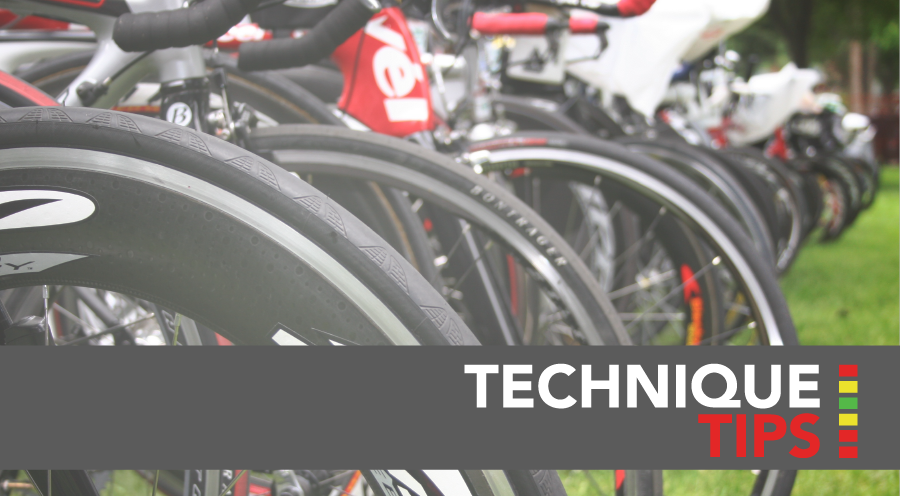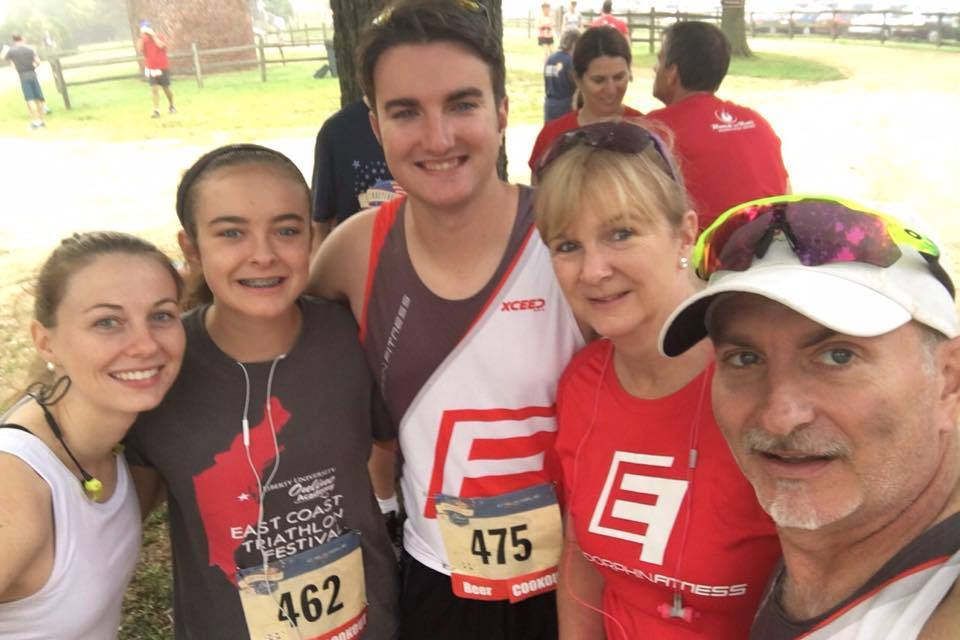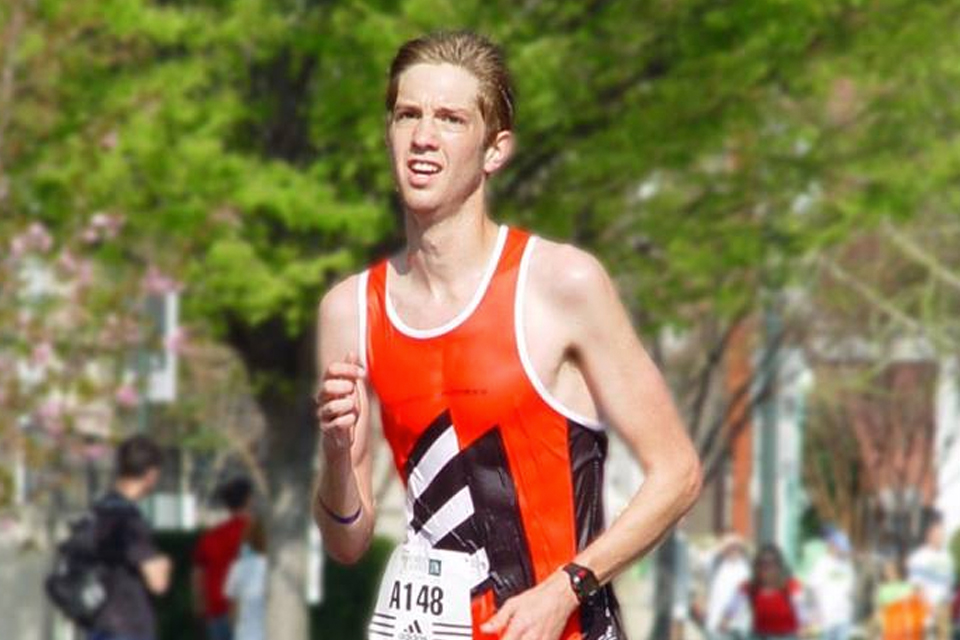

Practicing and Nailing Your Triathlon Transitions
Transitions are sometimes called the fourth discipline of triathlon. That’s because in addition to swimming, cycling, and running, you will also have to spend time going through transition. Just because you’re not competing in one of the main three events doesn’t mean the clock stops!
Regardless of whether you’re competing for a podium spot or a PR, you can always save time in transition. However, even if you just want to finish a strong race, simplifying and practicing transitions will help alleviate stress. If you’re not sure what you’re doing between the events, transitions can sometimes be overwhelming! It’s always a good idea to practice beforehand.
“Transition” in triathlon actually consists of a T1 (swim to bike) and T2 (bike to run). Many races will give you separate splits for the time spent between each leg. Every course is different and transition areas will vary somewhat, but the major aspects are the same from race to race.
We’re going to look at each stage of a triathlon transition in this article. I’ll walk you through each step and give some helpful tips that will help you save time on race day. Let’s get started!
T0- Setting Up Your Transition
Having a great transition starts even before the race!
On race morning (and sometimes the day before) you’re allowed into the transition area to get everything set up. The key here is to keep it simple. Only put the things that you’ll absolutely need during the race. Everything else should be left out in order to ensure a smooth and purposeful transition.
These are the basics. First, and most importantly, you’ll need your bike. Then to go with it, your helmet and bike shoes. You can put whatever you want on your bike for nutrition (including water bottles, energy bars, GUs, etc). Finally, I’ll put in my run shoes, race belt and race number, and sunglasses for the bike and the run.
If it’s going to be extremely sunny or hot, I might put a hat in transition as well. But more recently, I’ll even skip this as it’s one extra thing to think about. Again, keep it simple.
As I’m setting up my transition, I’ll talk myself through the race and touch the items as I go. I’ll say “First, I’m going to swim.” Then I’ll touch my swim cap, goggles, and my wetsuit (if it’s a wetsuit race) with me. These won’t stay in transition, but it’s the first part of the race so I’ll ensure I have those things first.
Then I say “After the swim, I’m going to come get on my bike.” I’ll touch the bike, helmet, sunglasses, and bike shoes. Then finally, “I’m going to do the run.” I touch the run shoes, race belt, and race number.
Once I ensure that everything is in place and my equipment is ready for the race, I leave transition. I don’t spend a lot of time in transition working myself up about exactly how everything will go. I get out and spend some time warming up!
T1- Swim to Bike
The race has started and you just crushed your swim. If you’re wearing a wetsuit, the first thing you should do for your transition is to have your wetsuit half off shortly after your water exit. This means unzipping the back and taking the top of the wetsuit off down to your waist. It’s a lot easier to take a wetsuit off once its wet, so it’s an easy way to save time as you’re running from the water to transition.
From there, run to your transition area. This is the area directly in front of your racked bike with a bin or a small area underneath your area on the rack. Take your wetsuit off, leave it under your bike, then put your helmet on first thing.
The rules for some forms of triathlon stipulate that you must have your helmet buckled before even touching your bike. However, all triathlon races require you to have a buckled helmet while riding your bike. It’s a good thing to get that done first thing before proceeding so you don’t forget!
Let’s talk about helmet and shoes really quick. If you’re not comfortable with a flying mount (more on this in a moment) you’ll want to put shoes on at the same time as your helmet. There’s a great drill for practicing this tricky maneuver at home.
If your adrenaline is pumping, the helmet and bike shoes can be a sticking point for some. However, there’s an easy drill you can do at home to get ready for your race. Simply set your equipment on the ground, spin in a circle several times, then practice putting on your shoes and clipping your helmet in one try while standing. Being a little dizzy and getting your heart rate up will help you practice so you’re ready to do the same thing under the pressure of a race.
Next, it’s time to take your bike out of transition. Take your bike off the rack and run with the bike to the mount line. You’ll either be doing a flying mount of mounting with your shoes already on your feet, but first, let’s talk about getting your bike there.
The easiest thing to do is to run with your hand on the seat, guiding your front wheel as if you were riding with no hands. This is quite a bit faster and more reliably moves the bike forward than putting your hands on the handlebar. It lets you hold most of the weight of the bike and helps keep it upright. It’s easy to practice this one- just walk around with your bike, hand on the seat, then progress to running!
Mounting your bike (flying, moving, or shoes still attached)
First and most importantly, a word on the mount line. You cannot mount your bike before the mount line, and you can mount your bike after it. Pretty simple. However, everyone is going to try to be mounting right at the line. I suggest taking your bike out a few more paces before even trying to get on. This will help give you some room and avoids a tangle if anyone else is having trouble.
Now that we’ve got that out of the way, let’s talk shoes.
The fastest way to get through transition is to leave your shoes attached to your bike through transition. You run the bike out of transition barefoot, mount your bike, and then get into your shoes after you’ve started moving forward. This approach has several advantages.
- Running in bike shoes with cleats on the bottom is quite difficult, and also damages the cleats.
- If you spend time time putting on your shoes while you’re already making forward progress, you’re already saving time.
If you’re not comfortable with the strategy outlined below, simply put your shoes on like I talked about above, mount after the mount line, clip in and away you go. However, if you’d like to save a little more time, let’s talk about a moving mount.
First, don’t do this for the first time on race day. You’ll want to get several practice sessions in to get totally comfortable with this technique. If it seems daunting to try alone, definitely reach out to me and we can set up a private session to practice this together!
Going back to your transition set-up, you’ll first want to make sure that your shoes were clipped in while on your feet. If you clip your shoes in by hand while setting up transition, you may not get the cleat all the way engaged. I’m going to assume you’re not reading this in the middle of the race, so make sure you make note of this for your set-up before the race :). Engaging the cleat to the pedal with your foot in the shoe and then taking the shoe off your foot while still attached to the bike is the safest method.
Now, after you pass the mount line a few yards, you’ll want to basically hop on your bike while still moving forward. I won’t go into too many details about the exact mechanics of how to do this. But if you’re not comfortable with the motion, you can still at least run barefoot to the mount line and, from a stand still, mount your bike with your bare feet on your bike shoes that are still clipped in.
If you can practice slipping your feet into your shoes while moving forward on the bike, you’ll save a ton of time over standing still and putting your feet in!
T2- Bike to Run
The first thing you’ll want to do for your bike to run transition is undo your shoes before the dismount line. It’s basically the reverse of the process mentioned above. You simply undo your straps while riding, slip your foot out, and then put your bare foot on top of the shoe. If you’re feeling bold, you can do a flying dismount, which I won’t go into here. However, it will still save you significant time to undo your shoe and have your feet free before the dismount line so you can start running with your bike quickly.
Again, if you want to spend some time working on a coasting dismount, definitely reach out! We’re happy to help.
Coming into transition, make sure you know where to bring your bike back to. I like to count the racks before the race to ensure I know exactly where my transition area is. Ensure that you bike is sturdy on the rack and won’t fall over, as this is both inconsiderate and may lead to a time penalty.
The second transition is a bit easier. The best thing you can do to quickly get your run shoes on is to have speed laces, which are elastic laces that you don’t need to tie. Practice a few times at home, and if you want to see what a fast T2 looks like, check out our transition challenge video here.
That’s it! Transition two is a lot easier. The biggest thing to keep in mind is making sure that all your bike equipment ends up back in your transition area and everything looks neat and tidy. Once your shoes are on, you can start running out of transition and towards the finish! There’s another chance for you to save some time here too, though: simply by putting on your race belt and number as you’re running, you can shave off some seconds you would’ve spent stopped doing the same thing.
Don’t neglect transitions
Transitions are a great place to save time. Think about how much work we put into our training to save 30 seconds off of a 5k time, and then imagine how much easier it would be to save 30 seconds if your transition skills aren’t sharp!
Also, make sure to familiarize yourself with the layout of transition, including the entrances and exits. I once had an embarrassing race where I tried to leave T2 out of the bike entrance. The announcer called out over the PA: “There goes Erin Horil, running the football to the wrong endzone!” It was embarrassing and disorienting, and could’ve been easily avoided by making sure I knew exactly where to go out of transition beforehand.
A great way to judge how fast your transitions are is to take a look at your splits within a race finish. Since a fast transition has much more to do with your technique than your fitness in swimming, biking, or running, you can generally asses how your transition skills stack up when comparing times within the same race. It may even be that you might have missed a podium spot not because you were slower than the person in front of you on the swim, bike, or run, but actually had a slower transition time!
Tighten up your transitions and you can be well on your way to saving minutes off of your race. Definitely reach out to me if you have any questions or want to practice this in a one-on-one private session! Happy training!





